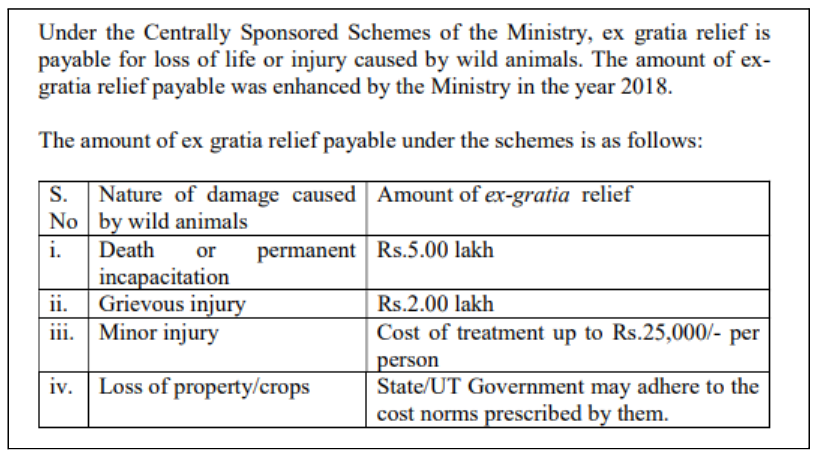The number of people killed in Tiger attacks crossed the 100 mark in 2022, a significant increase compared to the previous years. More than 600 people lost their lives in Tiger attacks between 2014 & 2024. On the other hand, more than 6000 people lost their lives in Elephant attacks between 2012-13 and 2023-24.
Owing to its varied ecosystems, ranging from dense forests to arid deserts, India is home to diverse wildlife including tigers, elephants, rhinos, deer, and many others. However, due to the limited nature of natural resources, there has been increasing competition between humans and wildlife in accessing and utilising the resources, paving the way for conflicts.
In this story, we look at the trends in the human death toll arising out of attacks involving two major mammals – tigers and elephants, the crucial keystone species, playing pivotal roles in maintaining ecosystem health and biodiversity. We also look at the trends in unnatural deaths of these mammals.
Data for this story is sourced from a recent parliamentary response, dated 24 November 2024, and Dataful’s collection on Human-Wildlife Conflicts. Data related to tigers is available for calendar years whereas for elephants, it is available for financial years.
Human-wildlife conflicts are multidimensional in nature
Human-wildlife conflict is a highly complex issue that is the amalgamation of ecology, human and wildlife behaviour, socio-economics, politics, and geography. These conflicts have a significant impact on the conservation of flora and fauna and pose a hindrance to human livelihoods and safety.
When understanding conflicts, various dimensions need to be considered. Anthropogenic factors include infrastructural development, encroachment, settlement, and livelihoods while the population of wildlife, migratory patterns, their habitat & degradation are some of the wildlife dimensions to be considered. The visible impacts of the conflicts on humans include damaged crops, and buildings, food insecurity and casualties & injury.
State forest officials are responsible for dealing with human wildlife conflicts
Usually, the Conservator of Forest (CF) of the Forest Circle and the Divisional Forest Officer (DFO)/ Wildlife Warden (WW) are responsible for dealing with the wildlife conflicts in their jurisdiction. They are overseen by the concerned state government. As per the Wildlife Protection Act of 1972, which is one of the key legislations concerning wildlife conservation in India, the central government sets the framework and guidelines while the states are responsible for managing and implementing these laws within their respective territories. In the case of death, persons from the Police Department and Revenue Department will be involved along with the Forest Department for carrying out documentation and post-mortem.
Over 600 people lost their lives in tiger attacks between 2014 and 2024
A total of 621 people were reported to have lost their lives in tiger attacks in the eleven years between 2014 and 2024 (up to 30 June 2024). In other words, an average of 56 people die in tiger attacks each year. About 40% of these total deaths were reported during 2021 and 2024. The year 2022 recorded the highest number of deaths in a year with 110 deaths.
4 out of 10 deaths were recorded in Maharashtra alone
Most of the human deaths due to tiger attacks between 2014 and 2024 were reported from Maharashtra, which accounted for 269 deaths or 43% of the total deaths. Uttar Pradesh recorded the second highest, with 111 deaths followed by West Bengal with 85 deaths. Together, these three states accounted for 75% of the deaths reported across the country.
In Maharashtra, there has been a substantial increase in the deaths reported over the years. While 7 deaths were reported in 2015, the number increased to 32 in 2021 and 85 in 2022 and had come down to 35 in 2023. In Uttar Pradesh, the number of deaths was 19 in 2017. Following a slight decline in the following years up to 2022, the number increased to 25 in 2023. On the other hand, the number has dropped in West Bengal during the same period, from 18 in 2015 to 1 in 2022, and zero in 2023. Even Madhya Pradesh has seen a decline in deaths despite being the state with the highest tiger population, as per the Tiger Census 2023. Maharashtra had 40% fewer tigers and yet reported more than 4 times the number of deaths.
While Assam recorded no deaths since 2019, Bihar reported a total of 15 deaths, all between 2020 and 2024. States with relatively higher tiger populations – Uttarakhand and Karnataka recorded a total of 19 and 19 deaths, respectively during this period.
No deaths were reported from the states of Andhra Pradesh, Arunachal Pradesh, Jharkhand, and Mizoram despite having tiger populations.
Unnatural Deaths of Tigers have declined in the recent years
As per the data from the National Tiger Conservation Authority (NTCA) and a parliament reply dated 25 November 2024, the total number of unnatural deaths of tigers from 2012 to 2024 (as of 20 November 2024) was 383. Of these, poaching alone accounted for 207 deaths at 54%, followed by Seizure with 101 deaths at 26%, and the rest due to other unnatural causes. In the year 2012, the total number of unnatural deaths was 46, which increased to 52 by 2014. Since then, it has reduced gradually and was 25 in 2023. While the deaths due to Poaching and Seizure have reduced from 2012 to 2024, the deaths due to other unnatural causes increased slightly in recent years.
Average of 517 lives lost in elephant attacks every year
Elephant attacks claimed 6,015 human lives in the twelve years between 2012-13 and 2023-24. On average, 517 people die every year, or about 10 every week. The highest number of deaths (628) was recorded in 2023-24. Apart from a higher population, elephant behaviour could also be a reason for the higher fatalities. Unlike tigers, elephants interact more with human settlements or agricultural areas, increasing the likelihood of conflicts. This can be in search of food, or due to migration and habitat fragmentation.
States in the East account for 10% of the Elephant population but 55% of the deaths
Among states, the highest number of deaths due to elephant attacks during this period was reported in Odisha (1170), followed by West Bengal (977), and Jharkhand (939). Assam reported 881 deaths. More than 500 deaths each were reported in Chhattisgarh and Tamil Nadu. Karnataka recorded 394 deaths and Kerala recorded 397 deaths between 2012-13 and 2023-24. As per the MoEF&CC, in 2017, the elephant population was the highest in Karnataka, followed by Kerala and Assam.
Though the states in the south (Kerala, Karnataka, Tamil Nadu, Andhra Pradesh, and Maharashtra) account for nearly half the elephant population as per the elephant population estimation, this region accounts for only about one-fifth of the deaths. In contrast, the states that fall in the eastern region (Odisha, West Bengal, Chhattisgarh, and Jharkhand) as per the report host about 10% of the elephant population but account for 55% of the deaths.
75% of Unnatural Deaths of Elephants were due to Electrocution
As per official data, from 2019-20 to 2023-24, a total of 528 elephants have died by unnatural causes such as train accidents, electrocution, poaching, and poisoning. Among these, deaths due to Electrocution were the highest during each year. A total of 392 elephant deaths were reported (75% of all) due to electrocution, followed by train accidents, poaching, and poisoning with 73, 50, and 13 deaths, respectively.
Compensation is paid for loss of life, injury, and loss of property
Ex-gratia compensation is paid by the government for loss of life and property caused by wild animals. For loss of life or permanent incapacitation, the compensation can go up to Rs. 5 lakhs and for grievous injury it can go up to Rs. 2 lakhs.

While it is an important mechanism to redress grievances and assuage the feelings of the community, it is often criticized for being a lengthy and time-consuming procedure. Late disbursal and insufficient amounts are also highlighted. The amount paid by each state is also different. For instance, Maharashtra pays Rs. 10 lakhs to the kin of the victim for loss of life while Karnataka government pays Rs.15 Lakhs.
Centrally sponsored schemes are being implemented to deal with conflicts
Elephants and tigers are the flagship species. That is, they draw attention to the importance of preserving entire ecosystems and serve as rallying points for conservation initiatives. For their conservation, the government has ‘Project Tiger’ and ‘Project Elephant’ which also includes measures towards management of human-wildlife conflict, sponsored by the Union government. Some of the physical measures taken are habitat management, early warning systems, fencing and barriers, community engagement, crop and livestock protection, and relocation and translocation.
The government also has the ‘Development of Wildlife Habitats’, a centrally sponsored scheme through which financial assistance is provided to states for the said cause. Measures are also taken by private NGOs to mitigate the same. The Environment Ministry also has a portal to register incidents of Human Wildlife Conflicts.
Featured Image: Tiger Attacks


